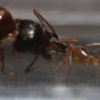- Formiculture.com
- Forums
- Gallery
- Members
- Member Map
- Chat

Lasius Queen ID
Started By
MC Wren
, Jun 4 2017 1:13 PM
30 replies to this topic
#21
 Offline
-
Posted June 8 2017 - 6:28 PM
Offline
-
Posted June 8 2017 - 6:28 PM
I'm stumped! The mandible and antennal scape hair characteristics would definitely make it seem like Lasius nearcticus! I guess I'll just need to wait and see what color they are in a few days.
#22
 Offline
-
Posted June 8 2017 - 7:42 PM
Offline
-
Posted June 8 2017 - 7:42 PM
I'm guessing that there are standing hairs there that you can't see, or this is Lasius alienus. Eurasian Lasius alienus do fly in the fall.
If you've enjoyed using my expertise and identifications, please do not create undue ecological risk by releasing your ants. The environment which we keep our pet insects is alien and oftentimes unsanitary, so ensure that wild populations stay safe by giving your ants the best care you can manage for the rest of their lives, as we must do with any other pet.
Exotic ants are for those who think that vibrant diversity is something you need to pay money to see. It is illegal to transport live ants across state lines.
----
Black lives still matter.
#23
 Offline
-
Posted June 9 2017 - 5:24 AM
Offline
-
Posted June 9 2017 - 5:24 AM
Well I'm not in Eurasia, so it's probably not Lasius alienus. If I remember today, I'll check for standing hairs that I missed.
#24
 Offline
-
Posted June 9 2017 - 7:19 AM
Offline
-
Posted June 9 2017 - 7:19 AM
Well I'm not in Eurasia, so it's probably not Lasius alienus. If I remember today, I'll check for standing hairs that I missed.
I think in another post @batspiderfish mentioned (can't find it but swear I saw it ![]() ), that they think there may be a Eurasian import of Lasius alienus (maybe even niger), in the United States, hence the different flight schedule.
), that they think there may be a Eurasian import of Lasius alienus (maybe even niger), in the United States, hence the different flight schedule.
#25
 Offline
-
Posted June 9 2017 - 9:14 AM
Offline
-
Posted June 9 2017 - 9:14 AM
Well I'm not in Eurasia, so it's probably not Lasius alienus. If I remember today, I'll check for standing hairs that I missed.
I think in another post @batspiderfish mentioned (can't find it but swear I saw it), that they think there may be a Eurasian import of Lasius alienus (maybe even niger), in the United States, hence the different flight schedule.
Lasius alienus is widely distributed throughout much of North America and is pretty common in the systems I work with in the northwest.
#26
 Offline
-
Posted June 9 2017 - 9:28 AM
Offline
-
Posted June 9 2017 - 9:28 AM
Well I'm not in Eurasia, so it's probably not Lasius alienus. If I remember today, I'll check for standing hairs that I missed.
I think in another post @batspiderfish mentioned (can't find it but swear I saw it), that they think there may be a Eurasian import of Lasius alienus (maybe even niger), in the United States, hence the different flight schedule.
Lasius alienus is widely distributed throughout much of North America and is pretty common in the systems I work with in the northwest.
I may have worded it poorly, I meant there may be a particular L. alienus sp variety that may be here more closely related to Eurasian L. alienus sp which is shown by their difference in flight schedules. I wish I could find the original post, he explained it better than I ![]() Not sure if it was here or on the Ants Canada forum. Hopefully he pops back in and says I am incorrect or can clarify.
Not sure if it was here or on the Ants Canada forum. Hopefully he pops back in and says I am incorrect or can clarify.
Edited by noebl1, June 9 2017 - 9:29 AM.
- VoidElecent likes this
#27
 Offline
-
Posted June 9 2017 - 2:32 PM
Offline
-
Posted June 9 2017 - 2:32 PM
Nothing concrete. It was a speculation from James Trager about some of the late-flying Lasius alienus sightings. The North American variety only flies from July to early August, while the European populations fly even later.
- noebl1, Nathant2131 and Cameron C. Thomas like this
If you've enjoyed using my expertise and identifications, please do not create undue ecological risk by releasing your ants. The environment which we keep our pet insects is alien and oftentimes unsanitary, so ensure that wild populations stay safe by giving your ants the best care you can manage for the rest of their lives, as we must do with any other pet.
Exotic ants are for those who think that vibrant diversity is something you need to pay money to see. It is illegal to transport live ants across state lines.
----
Black lives still matter.
#28
 Offline
-
Posted June 10 2017 - 11:33 AM
Offline
-
Posted June 10 2017 - 11:33 AM
Upon closer inspection under my microscope, it appears that there are some TINY hairs on the antennal scape. And I mean minuscule, they're barely visible.
Now that I googled Lasius neoniger antennal scape, I think she's Lasius neoniger because the hairs in the picture were pretty much exactly the same size.
Now that I googled Lasius neoniger antennal scape, I think she's Lasius neoniger because the hairs in the picture were pretty much exactly the same size.
- noebl1 and Nathant2131 like this
#29
 Offline
-
Posted June 10 2017 - 11:38 AM
Offline
-
Posted June 10 2017 - 11:38 AM
Standing hairs (Like the ones on L. neoniger) are also present on Lasius pallitarsis, But I believe the pictures of the queen were sufficient enough to rule out L. pallitarsis as there is an absence of an offset basal tooth. I would say Laius neoniger for this colony if there really are standing hairs on the scapes.
#30
 Offline
-
Posted June 10 2017 - 1:46 PM
Offline
-
Posted June 10 2017 - 1:46 PM
Upon closer inspection under my microscope, it appears that there are some TINY hairs on the antennal scape. And I mean minuscule, they're barely visible.
Now that I googled Lasius neoniger antennal scape, I think she's Lasius neoniger because the hairs in the picture were pretty much exactly the same size.
There is a distinction between appressed hairs (the fine ones that run somewhat parallel with the antennal scapes) and standing hairs, which stick out, away from the scapes. All of the Lasius in question have appressed hairs.
Edited by Batspiderfish, June 10 2017 - 1:47 PM.
- Nathant2131 likes this
If you've enjoyed using my expertise and identifications, please do not create undue ecological risk by releasing your ants. The environment which we keep our pet insects is alien and oftentimes unsanitary, so ensure that wild populations stay safe by giving your ants the best care you can manage for the rest of their lives, as we must do with any other pet.
Exotic ants are for those who think that vibrant diversity is something you need to pay money to see. It is illegal to transport live ants across state lines.
----
Black lives still matter.
#31
 Offline
-
Posted June 11 2017 - 1:19 PM
Offline
-
Posted June 11 2017 - 1:19 PM
These did stick out, they were just very small.
1 user(s) are reading this topic
0 members, 1 guests, 0 anonymous users
















